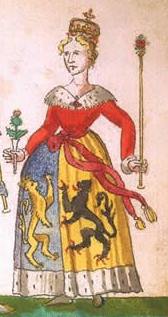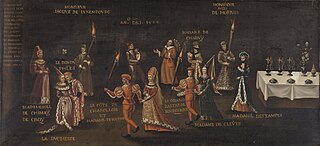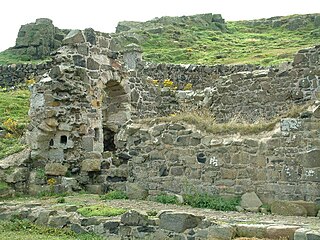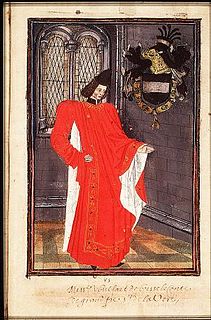Related Research Articles

Charles VI, nicknamed the Beloved and later the Mad, was King of France from 1380 until his death in 1422. He is known for his mental illness and psychotic episodes which plagued him throughout his life.

James II was King of Scots from 1437 until his death in 1460. The eldest surviving son of James I of Scotland, he succeeded to the Scottish throne at the age of six, following the assassination of his father. The first Scottish monarch not to be crowned at Scone, James II's coronation took place at Holyrood Abbey in March 1437. James II was known as Fiery Face, a reference to the vermilion birthmark covering the left side of his face, which was deemed by contemporaries as an outward sign of a fiery temper.

Enguerrand de Monstrelet was a French chronicler. He was born in Picardy, most likely into a family of the minor nobility.

Charles II, Duke of Bourbon, was Archbishop of Lyon from an early age and a French diplomat under the rule of Louis XI of France. He had a 2-week tenure as Duke of Bourbon in 1488, being ousted afterward by his younger brother and successor, Peter II, Duke of Bourbon.

John V of Armagnac, the penultimate Count of Armagnac of the older branch. He was the son of John IV of Armagnac and Isabella of Navarre.

Georges Chastellain, Burgundian chronicler and poet, was a native of Aalst in Flanders. Chastellain's historical works are valuable for the accurate information they contain. As a poet he was famous among his contemporaries. He was the great master of the school of grands rhétoriqueurs, whose principal characteristics were fondness for the most artificial forms and a profusion of Latinisms and graecisms.

Antoine de la Sale was a French courtier, educator and writer. He participated in a number of military campaigns in his youth and he only began writing when he had reached middle age, in the late 1430s. He lived in Italy at the time, but returned to France in the 1440s, where he acted as umpire in tournaments, and he wrote a treatise on the history of the knightly tournament in 1459. He became the tutor of the sons of Louis de Luxembourg, Count of Saint-Pol, to whom he dedicated a moral work in 1451. His most successful work was Little John of Saintré, written in 1456, when he was reaching the age of seventy.
Simon Morhier, lord of Gilles, near Nogent-le-Roi, in the Chartrain country, was a medieval French nobleman who sided with the English during the Hundred Years' War. He was provost of Paris during the English occupation in the 15th century, and remained a steadfast supporter of the English cause in France throughout his life.

Mary of Guelders was Queen of Scotland by marriage to King James II of Scotland. She ruled as regent of Scotland from 1460 to 1463.

Eleanor Cobham was an English noblewoman, first the mistress and then the second wife of Humphrey, Duke of Gloucester, who in 1441 was forcibly divorced and sentenced to life imprisonment for treasonable necromancy, a punishment likely to have been politically motivated.

The Feast of the Pheasant was a banquet given by Philip the Good, Duke of Burgundy on 17 February 1454 in Lille, now in France. Its purpose was to promote a crusade against the Turks, who had taken Constantinople the year before. The crusade never took place.

The Isle of May Priory was a monastery and community of Benedictine monks established for 9 monks of Reading Abbey on the Isle of May in the Firth of Forth, Scotland, in 1153, under the patronage of David I of Scotland. The priory passed into the control of St Andrews Cathedral Priory in the later 13th century, and in 1318 the community relocated to Pittenweem Priory on the Fife coast.
John IV was a Count of Armagnac, Fézensac, and Rodez from 1418 to 1450. He was involved in the intrigues related to the Hundred Years' War and in conflicts against the King of France.
Jean (II) Juvénal des Ursins (1388–1473), the son of the royal jurist and provost of the merchants of Paris Jean Juvénal, was a French cleric and historian. He is the author of several legal treatises and clerical publications and the Histoire de Charles VI, Roy de France is attributed to him. His works serve as some of the main sources for information relating to the Armagnac-Burgundian Civil War and the final phase of the Hundred Years' War.

Wolfert VI of Borselen was stadholder of Holland, Friesland, and Zeeland, Admiral of the Netherlands outside Flanders, and Lord of Veere.
Guillaume Cousinot de Montreuil (1400–1484) was a French diplomat, magistrate and civil servant. He served as France's diplomatic representative in England between 1444 and 1449, during a period of truce between the two countries.
Saint Adrian of May was a martyr-saint of ancient Scotland, whose cult became popular in the 14th century. He is commemorated on 3 December. He may have been a bishop of Saint Andrews.

Radegonde of Valois was a French princess, eldest daughter of King Charles VII of France and Marie of Anjou. She was betrothed to Sigismund, Archduke of Austria.

Bernard de la Salle, was a French mercenary captain during the Hundred Years War. His story is mentioned in the Chronicles of Froissart
Bernard de Wisk was a mercenary captain and sometime brigand of the Hundred Years War.
References
- ↑ Mathieu d’Escouchy, in: Encyclopedia of the Medieval Chronicle online.
- ↑ Christine McGladdery, James II (John Donald: Edinburgh, 1990), p. 45.
- ↑ G. Du Fresne de Beaucourt, Chronique de Mathieu d'Escouchy: 1444-1452, vol. 1 (Paris, 1863), pp. 177-8